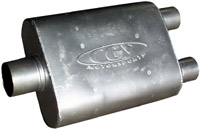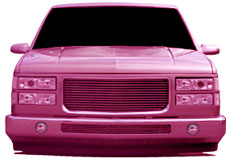
So you have a snazzy looking truck,
but you are afraid that your anemic exhaust tone will make people wonder
if it's all show and no go. Then maybe it is time to think about a new
exhaust system.
You don't have to look very hard to
realize that there are dozens of exhaust products to choose from. The
choices run the gamut from generic mufflers to specialized cat-back
systems. Before we get into the specifics, let's review a brief lesson
on exhaust systems.
Your exhaust system routes hot exhaust
gasses away from your engine. Modern vehicles are fitted with a catalytic
converter, commonly referred to as a "cat." The converter is a device that uses a catalyst to change harmful
compounds (hydrocarbons, carbon monoxide, and nitrogen oxides) found in
exhaust into less harmful compounds. The muffler serves to keep the
noise level down.
The converter is a device that uses a catalyst to change harmful
compounds (hydrocarbons, carbon monoxide, and nitrogen oxides) found in
exhaust into less harmful compounds. The muffler serves to keep the
noise level down.
The stock exhaust system found on most
trucks is a source of restriction. Often the stock pipes are formed
using crimped bends that may restrict the smooth flow of your exhaust.
Older vehicles can also suffer due to the clogged cat syndrome; the
ceramic beads inside the catalytic converter become clogged with
deposits and eventually restrict the exhaust flow. Finally, the stock
muffler on trucks is designed to keep the exhaust sounds to a minimum
without much regard for maximum performance or a powerful tone.
A new exhaust can increase horsepower and
torque, as well as change the exhaust tone. Although a free-flowing
exhaust can increase power, too much flow is not always a good thing.
Engines rely on some amount of back-pressure for desirable performance.
A small engine with greatly-oversized exhaust will lose a significant
amount of
low-end power. With the proper size exhaust and muffler, most
trucks can expect to gain 10 to 20-horsepower and similar amounts of
torque. Adding a high-flow catalytic converter can net additional gains.
 In
general, there are two approaches to installing a new exhaust system.
The first is a "cat-back" exhaust system. This system replaces the stock
exhaust from behind the catalytic converter to the tailpipe. The system
is usually sold as a complete kit and incorporates a high-flow muffler.
Several manufacturers produce cat-back exhaust
systems specifically made for each model of truck. The main benefit to a
cat-back exhaust is that the do-it-yourself mechanic can install the
system at home, using the supplied clamps. Although installation is
usually a clamp-on/bolt-on operation, removing your stock exhaust may
require some cutting. In
general, there are two approaches to installing a new exhaust system.
The first is a "cat-back" exhaust system. This system replaces the stock
exhaust from behind the catalytic converter to the tailpipe. The system
is usually sold as a complete kit and incorporates a high-flow muffler.
Several manufacturers produce cat-back exhaust
systems specifically made for each model of truck. The main benefit to a
cat-back exhaust is that the do-it-yourself mechanic can install the
system at home, using the supplied clamps. Although installation is
usually a clamp-on/bolt-on operation, removing your stock exhaust may
require some cutting.
The second approach is to have a custom
exhaust system made to suit your needs. This method allows you to choose
your own exhaust routing, exit location, muffler, and exhaust tips. Due
to the specialized tools needed to bend exhaust pipe and weld the system together, most people won't be
able to do a custom installation at
home. However a good exhaust shop can help design and install a custom
system, and the possibilities are endless.

A few things to consider when planning a new
exhaust system include the desired exhaust tone, in-cab noise level, overall fit,
materials, exit location, single or dual-exhaust outlets, and any
special exhaust routing that may be necessary. After some careful
consideration we decided that the truck we were working with, a
1995 Chevrolet C-1500 with a V8 engine, warranted a custom exhaust system. The slammed
stance compromised exhaust clearance over the rear axle and would need
something other than an off-the-shelf solution.
We decided to take our project truck to
the performance exhaust specialists at CGS Motorsports in Pomona, CA.
Their experience in custom exhaust system design and installation has
been proven time after time, as their work can be found on numerous
show-stopping vehicles.
We informed exhaust guru and company
owner, Casey Scranton, of our desire for a deep, rumbling exhaust tone
with a vicious growl under throttle. In no time he had the truck on
the lift and the installation already underway. Follow along as Casey
goes to work on our project truck.
|
